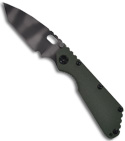

More accurately, they are zero ground that is, the edge has no secondary bevel, minimizing drag when used for cutting purposes. Hartsfield's knives are hard ground from differentially heat-treated A2 tool steel and are known for their distinctive chisel-ground blades. In the mid-1980s, individual Navy SEALs from a West Coast team had been using personally purchased custom fixed-blade knives made by Southern California knifemaker Phill Hartsfield. A pocket clip held in place by three screws allows the knife to be clipped to a pocket, web-gear, or MOLLE. Early knives were made with black linen micarta and later models featured a proprietary green color made exclusively for Emerson. Most models feature traction grooves for a more secure grip in a wet environment and a chamfered lockface. The screws in the handle, and pivot are traditional straight-head screws to accommodate easy disassembly in the field with an improvised tool, if needed.

The reasons for using titanium as a linerlock material were due to its memory characteristics and corrosion resistance. Titanium bolsters make up the front half of the knife with the back half represented by linen micarta scales. The handle material of the CQC-6 is composed of two titanium liners utilizing a Walker linerlock and a single or double detent as the locking mechanism, although one experimental model exists with a ratchet lock. Unlike the typical Japanese chisel-grind, Emerson's grind is on the left-side of the blade as opposed to the right-side. Early models have a buffline similar to a hamon found on a Japanese Samurai Sword due to a leather buffing wheel used by Emerson to finish his blades. The blade profile of most CQC-6's is a Japanese chisel ground tantō with a single bevel or zero-ground blade sharpened on only one side. The butt-end of the knife tapers to a point and features a hole for tying a lanyard. The handle is 4 5/8" long making the knife close to 8 inches in length when opened. The CQC-6 is credited as the knife that popularized the concept of the tactical folding knife. It has a chisel-ground blade of ATS-34 or 154CM stainless steel and a handle made of titanium and linen micarta. Although initially reported as the sixth design in an evolution of fighting knives and the first model in the lineup of Emerson's Specwar Custom Knives, Emerson later revealed that the knife was named for SEAL Team Six. The CQC-6 ( Close Quarters Combat - Six) or Viper Six is a handmade tactical folding knife with a tantō blade manufactured by knifemaker Ernest Emerson. Spearpoint, hollow-ground, right-side grind, and damascus blades Desert Storm, War on Terror, Operation Iraqi Freedom


 0 kommentar(er)
0 kommentar(er)
